About Sharon Zook:
Sharon Zook of Lebanon County, PA creates quilts and braided rugs from old clothing and fabric scraps. It’s a useful art form that most households practiced a generation or two ago, but has become uncommon in today’s throw-away culture. In March 2021, Sharon showed folklorist Amy Skillman how she combines colors and patterns to make lovely things that are greater than the sum of their parts.
Sharon’s last name, Zook, rhymes with book.
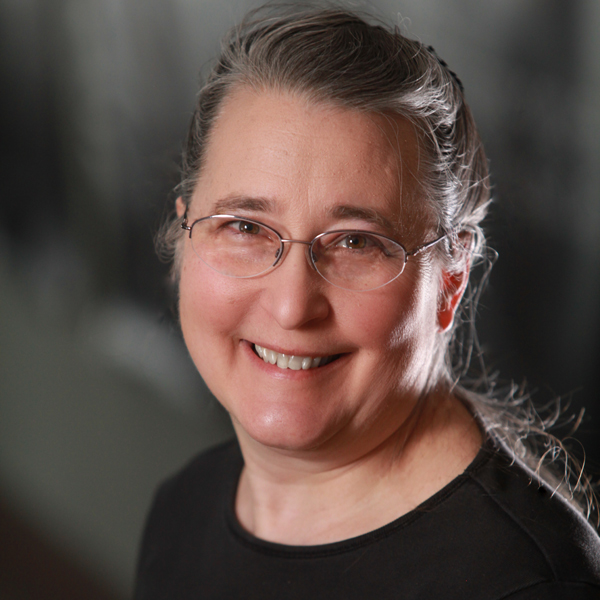
portrait of Sharon Zook courtesy of the artist
About Sharon Zook
A family of quilt-makers
Two quilts hang side by side, a study in old and new. One is a very traditional patchwork, a colorful riot of old-fashioned calicos and solids. Beside it is an elegant contemporary design of lavender strips against a glittery purple background, with sampler blocks of traditional quilt patterns interpreted in lavender along the edge. Both of these quilts are made by Sharon Zook, illustrating history and innovation in an artistic tradition that’s been part of her family life for generations.
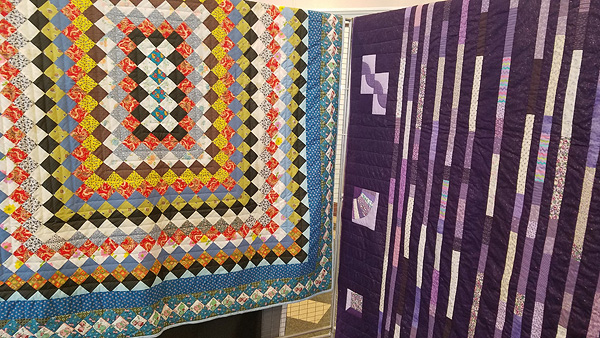
photo by Amy Skillman
Both of these quilts are made from leftover scraps: quilters are thrifty folk who regard fabrics as much too valuable to throw away. The traditional quilt is made from cloth Sharon’s maternal grandmother used for handmade aprons, with a border of vintage fabrics that was made years ago for some other project but later removed. The modern purple quilt makes use of leftover bits from a quilt Sharon’s maternal grandmother and aunt were commissioned to make for the Mayor of Lebanon many years ago. “Yeah,” she says, “growing up with Amish and Mennonite grandmothers, I couldn’t get away from quilting.”
Sharon explains that her grandmothers made a lot of quilts (and collected lots of scraps for quilts!) over the course of their lives — and when they passed, “I got the leftover scraps, because it’s what I do.” When she was young, the quilts were set up in the parlor at the farmhouse of her maternal grandparents. “Then after [my grandmother] moved into the ranch house on the same property, she had the basement finished out and the quilting would be set up in the basement. People would come together and quilt.”
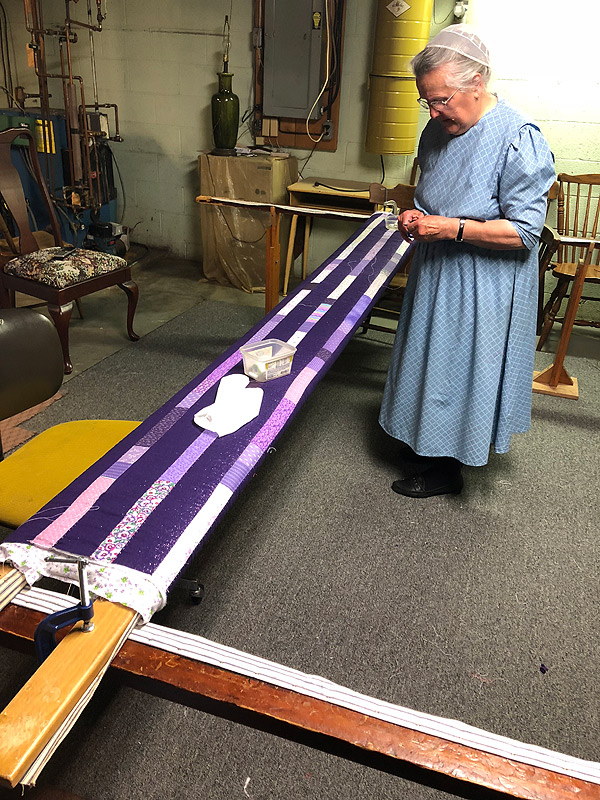
photo courtesy of the artist
The first quilt Sharon made was from blocks she cut out when she was nine years old. She didn’t do the piecing or quilting at the time, but when she was ready, she returned to those old blocks for inspiration... and because she can’t stand to see anything go to waste.
Patterns and design
Log Cabin and Trip Around the World were two popular quilt patterns in her family. Trip Around the World “is a good pattern because you can use up a variety of blocks in a variety of colors and with varying amounts of each.” She explains that you start with one block in the middle, then add four alike around that, then eight around those, and so on. This results in a diamond shape, with the corners pointing to the middle of each long edge of the quilt.
Once the points reach the width you want the finished quilt to be, you fill in the corners, moving back down from eight squares to one at each of the corners. Sharon made one Trip Around the World quilt where each corner was in a different color scheme, based on the number of blocks she had in each color — observing that “basically, it’s a waste of material unless you do something with it.” It takes a lot of mathematical figuring, to match what you have with what you want to create.
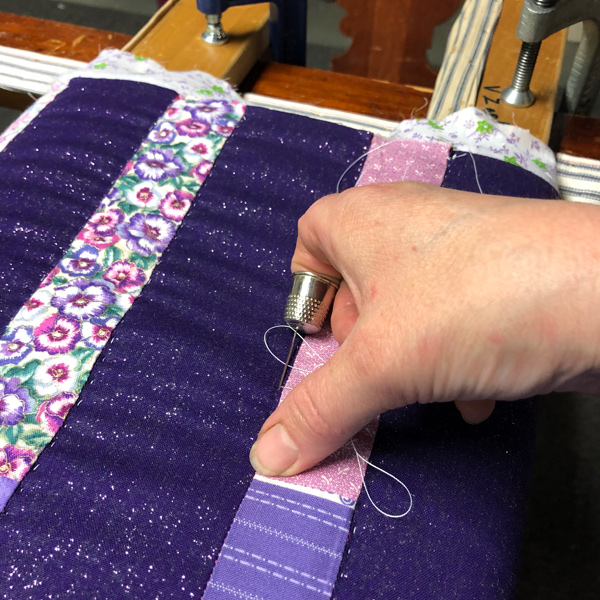
photo courtesy of the artist
The making of a quilt
“The composition of a quilt is a back, a top which is usually decoratively pieced, and then some kind of insulation material in the middle — some kind of filler. It is usually cotton or Dacron batting. But sometimes we’ll put a flannel sheet in the middle or something like that. Then you need to figure a way to bind all those layers together so that when they are washed, they don’t separate. Quilting was the more artistic form. But if you really needed to get it together fast, and if it keeps you equally warm, then knotting was the form.”
For that final assembly, Sharon will sometimes send a finished quilt-top out to someone who has a quilting machine. However, for the quilts that she made from her grandmother’s pieces, or those she makes with special patterns, she says, “those are quilted by hand. Those I don’t waver on... the hand quilting can be done in patterns that accent the design of your pieces... I don’t want stitching [to detract from] my patterns. With hand quilting you can control that.”
Sharon’s favorite part of making a quilt is the piecing: combining colors and squares into pleasing patterns that make the most of the fabrics she has. Along with her grandmothers’ scraps, she has boxes of scrap fabric left over from other quilts she has finished, as well as scraps that have already been cut. It is not uncommon for elders in the community to cut blocks; they enjoy having something useful to do.
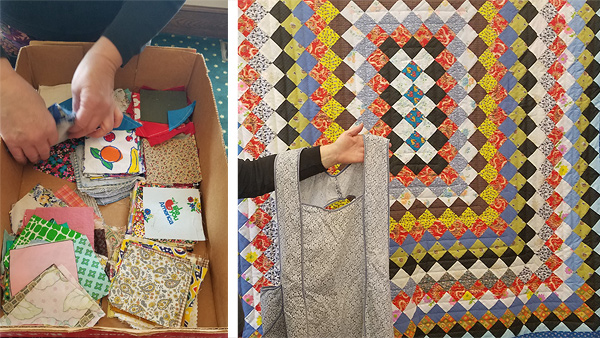
photo by Amy Skillman
As she leafs through her piles of squares, Sharon says, “I had a dress like this, my mom had a dress like this; so this is leftover fabric from making those dresses... And these scraps must be from Grandma Zook’s side because these are the kind of scraps she would use. She was from Amish and they never had florals... It’s going to be fun to figure something out; to figure out what I do to keep them grounded.”
Working without a pattern
Sharon says it is typical for her to work without a pattern. She enjoys figuring out how to incorporate design inspirations she’s seen elsewhere. Speaking about the purple quilt she just finished with her Grandmother Zook’s fabrics, she says: “I do things in spurts. I had this concept that I wanted to put samples of all her patterns into the quilt, so I would remember the different patterns. And, I wanted to arrange this in the non-traditional way, making it more like a contemporary themed pattern. I thought I could embed [her traditional patterns] somewhere. But it didn’t come together. I got to a point where I got stalled.”
The challenge was that the traditional squares were different sizes. She wanted to put them on the border but had to piece it together so it would be the width of the largest one. She put it together one way and “then I sent it to my mom. And after it was with my mom awhile, she had another idea that she thought worked better. I think we ended up disconnecting [the border] and flipping it around.” That worked.

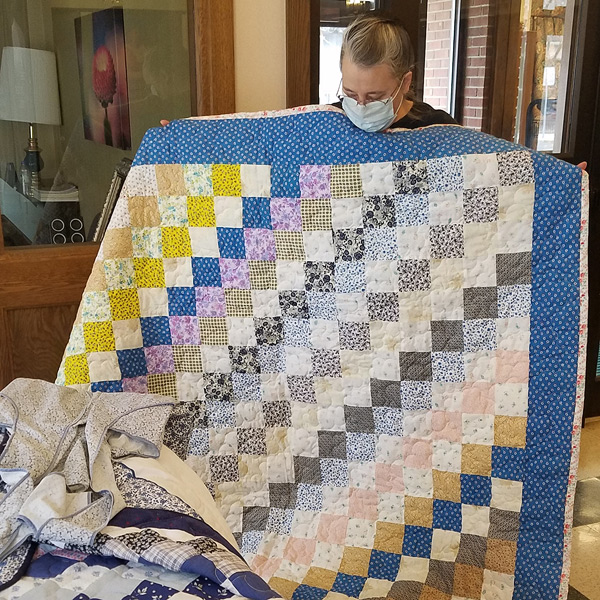
photo by Amy Skillman
Layers of warmth
Sharon’s mother sews a lot for relief efforts — she makes dozens of quilts each year to send to families lacking warmth in their homes — so she makes patterns with larger blocks which can be assembled quickly. But Sharon notes that if she cuts off edges to make the blocks match, she’ll put those in a box and then pull them out later to make a quilt. She also gets some blocks from a re-use-it craft store in Lebanon.
Like her grandmothers before her, Sharon also gets commissions to create commemorative quilts. She is currently working on two quilts that will honor the lives of two people who have made important contributions to the city of Lebanon. These are themed quilts so each block tells a story specific to the life of the recipient. For these, she is using appliqué, embroidery, piecing, and even photographs printed on fabric. These quilts will most likely hang on a wall, but they are rooted in generations of resourceful women merging beauty and function to shelter others.
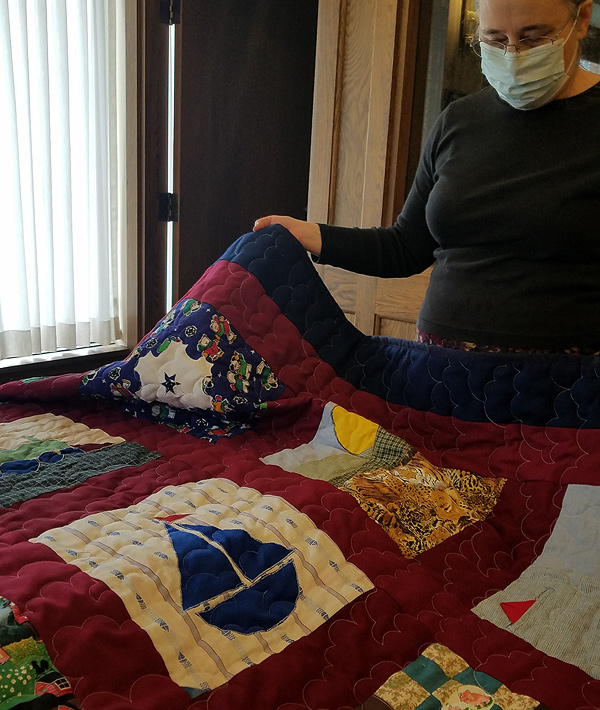
photo by Amy Skillman
From quilts to braided rugs
That same passion for making beauty out of scraps is what motivated Sharon to take up rug braiding. She first learned about rug braiding from a neighbor after moving into the city about 20 years ago. At first she didn’t appreciate the rugs. “But once I learned what wool braided rugs really were, I got hooked on it. Because, again, you could take old clothes, braid them together — and I like braiding — and lace it together and have something beautiful and functional”
People who know of her passion for braiding give her wool fabric and clothing. Skirts and pants are the best because they make nice long strips. Jackets and blazers are not prime pieces because the strips are shorter. “But if it is a good red or purple, I’ll take it anyway because they can add a lot of color. I accept all donations.”
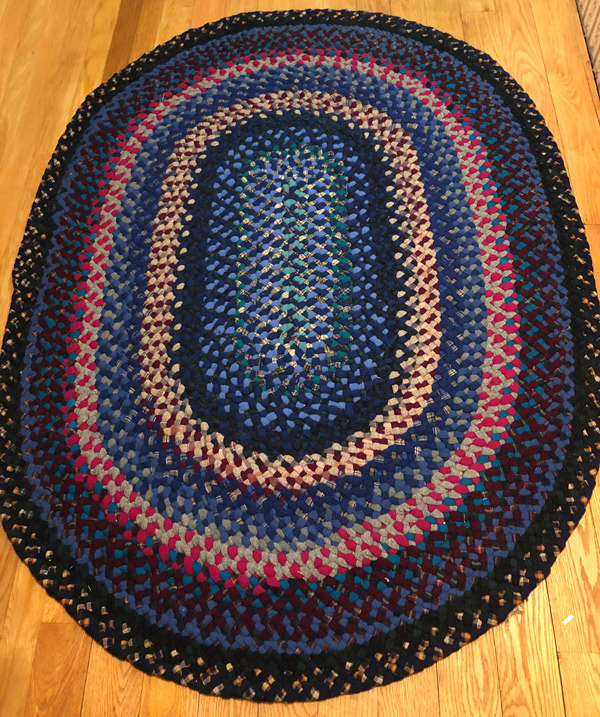
photo courtesy of the artist
Preparation and planning
The first step is to wash the fabric in an agitator washer, which “felts” the wool, meshing its fibers together and making the fabric more dense. Then drying it on the highest heat shrinks the fibers as much as possible. After it is felted, the fabric tears easily in a straight line. Sharon uses 2¼-inch strips, because “my fingers are used to that size.” All the rug braiding books will tell you to take the seams out of the clothes, flatten them, remove the buttons, etc. “But I cheat with everything,” Sharon says as she rips a wool skirt into strips, from bottom to waistband, all the way around. She just works around the parts of the garment that she can’t use. (But, of course, she saves the cool buttons.)
Instruction books talk about how many pounds of wool to use, but that doesn’t work for Sharon. She rolls same-color strips into a wheel to store, and she knows by the size of the wheel how much she will get out of it. When she has enough rolls in a color scheme she likes, she puts them all in line to see what size the rolls are. She uses the smaller rolls in the center, because she doesn’t need as much for those smaller rings, and builds outward with larger wheels creating the larger rings. She might braid a particularly nice color with a complementary strip so the primary color will last longer. “If I have a nice big wheel of red, and if I want some brightness, I can wait until I am out here [she points to the outer rings of a finished rug] and still have enough to get some real good color.”
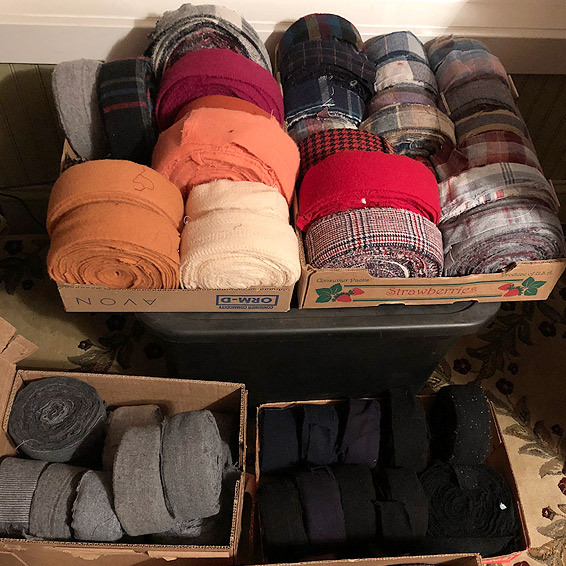
photo courtesy of the artist
Braiding and lacing
While the braiding might seem straightforward, it is tricky to create a smooth, even surface. As you braid, you fold the edges of the strip inward into itself, so the raw edges of the strip are hidden. The folded edges are visible on the back of the braid, but not on the front.
“I braid for a number of days or weeks, until I have maybe equal to a clothes basket full of braids, and then I start looking at it. You have to have some idea in your head of what you want your proportions to be.” She coils the braids on the floor as she goes, to see how it is coming out. To really see the pattern and calculate her increases, she must start lacing it together. Some people lace as they go along, but Sharon likes to have a good amount of braiding before she starts lacing.
The lacing is done with thin cord which holds the braids in place and connects the rings as the rug grows larger. Sharon is careful to ensure her lacing doesn’t show, so that the rug can be reversible. “When you start lacing, you need to know how long to make that middle ‘tail’ in the very center of the [rug] before you start turning the corner... That’s going to determine the relationship of the overall width to the length. The ratio is length minus width equals the center strip right in the middle.” So a rug that is five feet by seven feet will have a center strip that’s two feet long.
Tearing the wool into strips can be dusty work, so that is a good project to do outside in the summer. The actual rug-making is pleasant work in the winter, “because it’s cold and it’s dark, and you have wool which is warm, and the cat climbs around and thinks she owns the new rug. So you can make it into a year-round hobby.”
Each rug is a teacher
One of Sharon’s favorite creations is a rug she calls Rhapsody in Blue. She had a good amount of a beautiful blue and wanted to keep it flowing through the whole rug. She showed her work in progress to a friend, who told her she needed to stop with the blue at a few points in order for the blue to really pop and stand out. Sharon was skeptical, and a little disappointed at first, but she found other colors to alternate with the blue and realized that her friend was right. “It becomes greater than what it is. It looks more planned out.” She says she learned a lot about color while making that rug. “I just had a nebulous idea of what it was going to look like. I assumed to make it look all blue, I had to continue the blue. That’s where I learned that just continuing one color doesn’t necessarily intensify the color...”
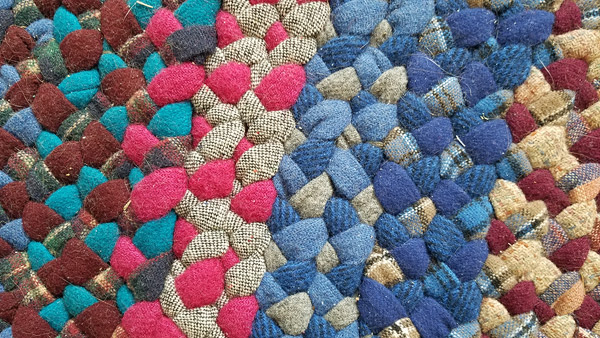
Rhapsody in Blue, up close - photo by Amy Skillman
A well-made wool rug has nice tight braids, with the strips neatly folded so the edges of the strips are hidden and won’t fray. The real challenge in making braided rugs is lacing them so that they lie flat, especially when the braid is going around bends. Sharon observes that lacing is tricky, and “you can’t always tell if you’ve got it until you are out farther.” If the rug is wavy or lumpy, you might be able to fix it with moisture and heat. Her mother has helped her try to repair other people’s rugs. She once even had to cut out the center strip to get the rug to lay flat. “After you make that cut, you are at the point of no return. And you have to cut it before you know if it’s going to work.”
Playing with color
“I have no idea why I like messing in wool. I just like the feel of it,” Sharon says. “You can see you’re getting somewhere. There is a lot of good feedback with this, just merging the colors... you start combining some of these color combinations into braids and now you have something that’s totally different from just an individual color in a roll.”
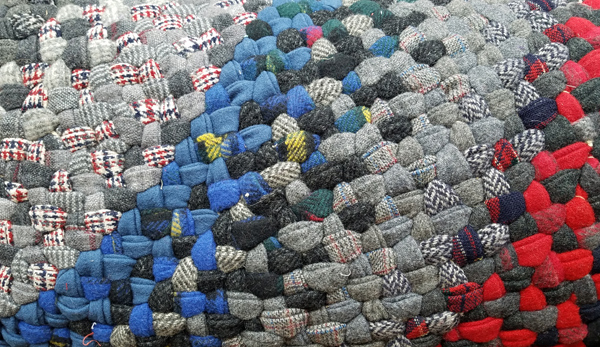
photo by Amy Skillman



Brand icons for Facebook, YouTube, Instagram and other social media platforms are the trademark of their respective owners. No endorsement is implied.